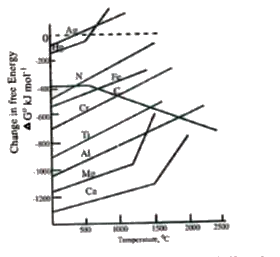Which of the following metals) can be obtained by electrolysis of their aqueous salt solutionsSolution in Telugu
Ag
Mg
Cu
Zn
The correct Answer is:B
Electropositive metals cannot obtained by the electrolysis of their aqueous salt solutions, i.e., salt slution of Na, k, Mg.
Topper's Solved these Questions
- METALLURGYBook:AAKASH SERIESChapter:METALLURGYExercise:LEVEL-II (LECTRURE SHEET) (EXERCISE-II) (PASSAGE-I)
Explore 5 Videos
- METALLURGYBook:AAKASH SERIESChapter:METALLURGYExercise:LEVEL-II (LECTRURE SHEET) (EXERCISE-II) (PASSAGE-II)
Explore 4 Videos
- METALLURGYBook:AAKASH SERIESChapter:METALLURGYExercise:EXERCISE - 7.2
Explore 23 Videos
- IONIC EQUILLIBRIUMBook:AAKASH SERIESChapter:IONIC EQUILLIBRIUMExercise:ADDITIONAL PRACTICE EXERCISE (PRACTICE SHEET ( ADVANCED))
Explore 11 Videos
- NITROGEN CONTAINING COMPOUNDSBook:AAKASH SERIESChapter:NITROGEN CONTAINING COMPOUNDSExercise:Conversions
Explore 18 Videos
Similar Questions
Electrolysis is an important technique for extraction of metals and each low of the solution needs a minimum voltage to get discharged and this value is expressed in terms of discharge potential. For some metal ions the discharge potentials follow the order give below :
Li+>K+>Ca2+>Na+>Mg2+>Al3+>Zn2+>Fe2+>Ni2+>H3O+>Cu2+>Hg2+2>Ag+>Au3+ For some anions the discharge potentials are in the order:
SO2−4>NO−3>OH−>Br−>I−
When aqueous solution of cuprous bromide is electrolysed the product obtained a cathode will be
View SolutionFor a spontaneous reaction, the free energy change must be negative. ΔG=ΔH−TDelaS is the enthalpy change during the reaction. T is absolute temperature, and AS is the change in entropy during the reaction. Consider a reaction such as the formation ofan oxide .
M+O2MO
Dloxygen is used wp in the course of this reaction. Gases have a more random structure (less ordered) than liquid or solids consequently gases have a higher entropy than liquids and solids, in this reaction (entropy or randomness) decreases, hence is negative. Thus, the temperature is raised the ΔS becomes more negative. Since, TΔS is subtracted in the equation, then SG becomes less negative. Thus, the free energy changes increases with the increase in temperature.
The free energy changes that occur when one mole of common reactant in this case dioxygen) is we may e plotted graphically against temperature for a number of reactions of metals to their oxides. The following plot is called an Ellingham diagram for metal oxide. Understanding of Ellingham diagram is extremely important for the efficient extraction of metals.

For the conversion of Ca(s) to CaO(s) which of the following represent the ΔG vs T :
View SolutionMetal sulphides occur mainly in rocks, but metal halides occur in lakes and sea. Why ?
View SolutionA solution contains 0.05M of each of NaCl and Na2,CrO4,. Solid AgNO3, is gradually added to it. Whichof the following facts true
(Given: Ksp(AgCl)=1.7×106(−10)M2 and Ksp(Ag2,CrO4,)=1.9×10−12M3:
View SolutionEthanamine to methanamine
View SolutionThe metals that cannot be obtained by electrolysis of the aqueous solution of their salts are
View SolutionWhich of the following metal can be obtained by the electrolysis of the aqueous solution of their salts ?
View SolutionWhich metal can not obtained by electrolysis of their aqueous salt solution ?
View Solutionनिम्न में से कौन-सी धातु अपने लवणों के जलीय विलयनों के विद्युत-अपघटन से प्राप्त नहीं हो सकती है ?
View SolutionOf the following, the metal which cannot be obtained by electrolysis of the aqueous solution of their salts is
View SolutionWhich metal can not obtained by electrolysis of their aqueous salt solution ?
View Solutionधातु जो अपने लवणों के जलीय विलयनों के विद्युत अपघटन से प्राप्त नहीं हो सकती होती है
View SolutionOut of the following metals that cannot be obtained by electrolysis of the aqueous solution of their salts is
View SolutionThe metal that cannot be obtained by electrolysis of the aqueous solution of their salts is
View Solutionनिम्न धातुओं में से जो इनके लवणों के जलीय विलयन के विद्युत अपघटन द्वारा प्राप्त नहीं हो सकता है
View Solution

